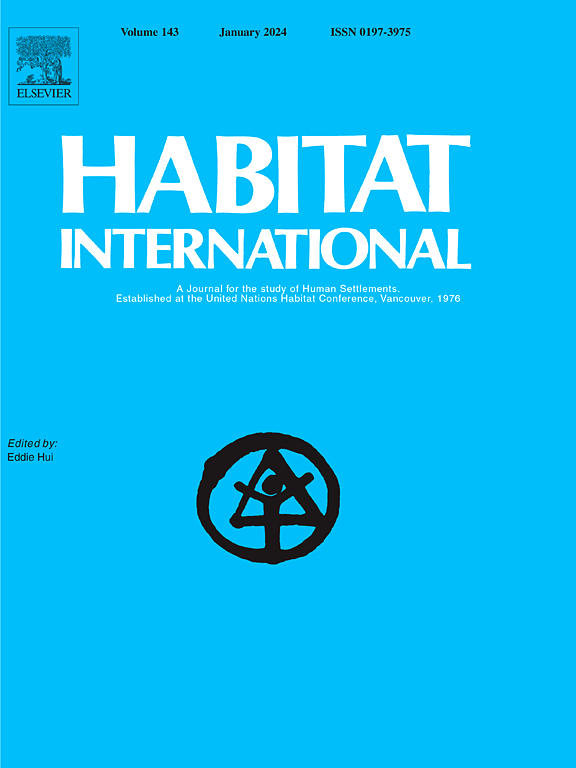Australian nationwide assessment of social vulnerability in two decades through its linkage to the built environment
IF 7
1区 经济学
Q1 DEVELOPMENT STUDIES
引用次数: 0
Abstract
Evaluating social vulnerability and identifying at-risk populations are foundational to hazard risk mitigation and sustainable human settlement, yet these tasks entail distinct challenges that vary across urban-rural contexts and temporal scales. Despite Australia's escalating exposure to natural disasters, longitudinal, nationwide metrics of social vulnerability remain absent, with prior research constrained to localized or temporally fragmented analyses. Grounded in Cutter's social vulnerability framework, this study develops fine-grained, longitudinal indices of social vulnerability for urban and rural Australia across five census cycles (2001–2021). Spatial inequities, temporal trends, and associations between social vulnerability and 30 built environment indicators were analyzed using interpretable machine learning techniques. Key findings reveal that while the geographic distribution of the most vulnerable areas has remained stable over time, socioeconomic inequities of such areas have diminished whereas spatial clustering intensified. Resilient regions are characterized by enhanced access to public amenities, housing diversity, and commercial density—factors that collectively attenuate vulnerability. Furthermore, upgraded built environments attract socioeconomically advantaged populations, amplifying aggregated resilience. To our knowledge, this represents the first comprehensive, longitudinal, and spatially explicit national assessment of social vulnerability in Australia over two decades. The results elucidate critical trends in vulnerability and their interplay with built environment dynamics, offering actionable insights for place-based hazard mitigation, urban-rural sustainability, and infrastructure resilience. By bridging data gaps, this work addresses Australia's pressing need for evidence-driven policy and spatially targeted interventions to counter intensifying natural hazards and prioritize the resilience of human settlement.
通过与建筑环境的联系,对澳大利亚20年来的社会脆弱性进行全国性评估
评估社会脆弱性和确定高危人群是减轻灾害风险和可持续人类住区的基础,但这些任务所面临的挑战因城乡背景和时间尺度而异。尽管澳大利亚遭受自然灾害的风险不断增加,但纵向的、全国性的社会脆弱性指标仍然缺乏,之前的研究仅限于局部或暂时分散的分析。在Cutter的社会脆弱性框架的基础上,本研究开发了五个人口普查周期(2001-2021)澳大利亚城乡社会脆弱性的细粒度纵向指数。使用可解释的机器学习技术分析了社会脆弱性与30个建筑环境指标之间的空间不平等、时间趋势和关联。主要研究结果表明,虽然最脆弱地区的地理分布一直保持稳定,但这些地区的社会经济不平等现象有所减少,而空间聚集性加剧。弹性地区的特点是公共设施、住房多样性和商业密度增加,这些因素共同降低了脆弱性。此外,升级的建筑环境吸引了社会经济优势人群,扩大了总体复原力。据我们所知,这是澳大利亚二十年来首次对社会脆弱性进行全面、纵向和空间明确的国家评估。结果阐明了脆弱性的关键趋势及其与建筑环境动态的相互作用,为基于地点的灾害缓解、城乡可持续性和基础设施复原力提供了可操作的见解。通过弥合数据差距,这项工作解决了澳大利亚对以证据为导向的政策和有空间针对性的干预措施的迫切需求,以应对不断加剧的自然灾害,并优先考虑人类住区的复原力。
本文章由计算机程序翻译,如有差异,请以英文原文为准。
求助全文
约1分钟内获得全文
求助全文
来源期刊

Habitat International
Multiple-
CiteScore
10.50
自引率
10.30%
发文量
151
审稿时长
38 days
期刊介绍:
Habitat International is dedicated to the study of urban and rural human settlements: their planning, design, production and management. Its main focus is on urbanisation in its broadest sense in the developing world. However, increasingly the interrelationships and linkages between cities and towns in the developing and developed worlds are becoming apparent and solutions to the problems that result are urgently required. The economic, social, technological and political systems of the world are intertwined and changes in one region almost always affect other regions.
 求助内容:
求助内容: 应助结果提醒方式:
应助结果提醒方式:


